Vietnam is a country with a rich and diverse culinary culture, and its drinks are no exception. This article is about some of the most popular drinks in Vietnam that you should try.
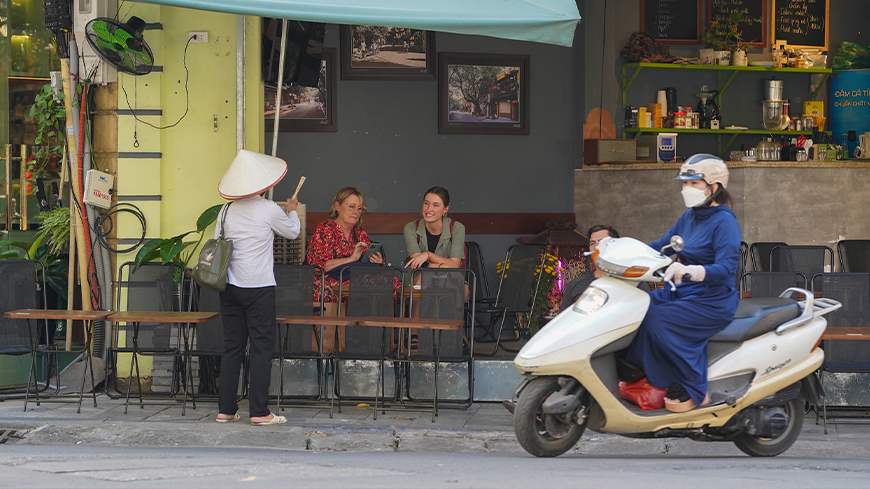
Ca Phe in Ha Noi - Photo : Mr Linh's Adventures
COFFEE, A DRINK WITH A UNIQUE FLAVOUR
In Vietnamese culture, coffee is a must-drink anytime of the day.
Origins of coffee in the Land of the Blue Dragon
It was the French settlers who imported coffee to Vietnam in the 19th century. They first introduced the Arabica coffee variety, but soon discovered that it was susceptible to diseases and parasites. They then turned to the Robusta variety, more resistant and with the best yields. This variety was quickly adopted by the Vietnamese, who created their own methods of cultivation and preparation. Coffee culture has grown so rapidly that the country has become one of the world’s leading coffee producers. Currently, the country with the two Deltas occupies the second place in the world in terms of Robusta production, after Brazil.
Coffee cultivation has had a profound impact on Vietnamese society: by creating new jobs and economic opportunities, it has contributed to the growth of the Vietnamese middle class.
Coffee, part of Vietnamese culture
In Vietnam, coffee is more than just a drink. It is part of Vietnamese culture. Cafes are common places where people meet to chat, drink coffee and share a snack.
Coffee also represents the modernity and openness of Vietnam to the world.
The different coffee preparations in Vietnam
Often served in traditional cafés, called "cà phê", the divine black beverage can be prepared in several ways. The most traditional method is filter coffee (ca phe phin, in Vietnamese). The ground coffee is placed in a metal filter, which then sits on top of a cup. The hot water is poured over the coffee, the coffee filters drop by drop in the cup, giving a concentrated drink and powerful in taste.
Another popular method is Vietnamese filter coffee. This method is similar to traditional filter coffee, but the coffee is ground more finely and the filter is placed in a glass container. The coffee filters drop into the container, and the coffee is then served with sweetened condensed milk.Le café vietnamien et ses declinaisons
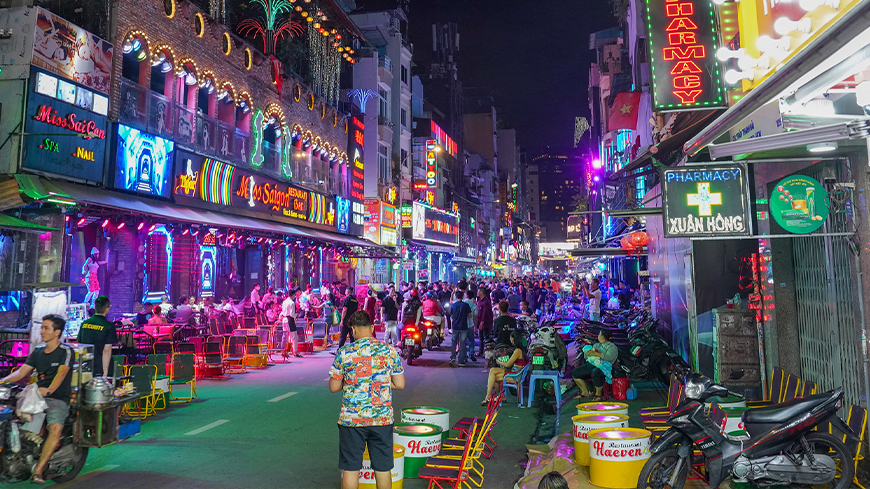
Bui Vien street in Saigon - Photo : Mr Linh's Adventures
Most Vietnamese coffee is iced and heavily sweetened. Here are some of the unique styles popular in Vietnam:
- ♦ Ca phe Hanoi (Hanoi-style coffee) – Ca phe den nong (black hot coffee)
This coffee is short and strong, with a thick consistency. It's frequently served with green tea to cleanse the tongue between drinks.
Ca phe sua nong / Ca phe nau nong (Hot coffee with milk, south )
This is Vietnam’s standard coffee drink. It combines rich Robusta coffee with sweetened condensed milk. Coffee is prepared in the same way as hot black coffee, then condensed milk is added. The milk to coffee ratio is usually 50/50.
Note : For these two versions, there is a iced version: we then say ca phe den da / ca phe nau da
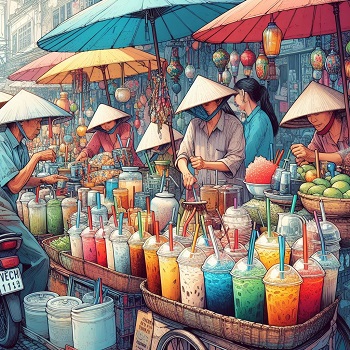
- ♦ Ca phe trung (egg coffee)
This drink, created in Hanoi's Old Quarter, originally appeared on the scene in the 1940s, when milk was in limited supply. Condensed milk is whisked with raw egg yolk to provide a light, fluffy froth as a replacement. It is then poured into the coffee and is frequently topped with sugar. Many travelers compare it to eggnog or tiramisu, both of which are fantastic!
- ♦ Ca phe sua chua (yoghurt coffee)
Another product introduced to Vietnam by the French was yoghurt. Although it may sound unusual to those of us in the West, yoghurt coffee is really popular in Vietnam! If you enjoy creamy coffee, you'll enjoy this combination of luscious yoghurt and aromatic black coffee. Yogurt coffee is sometimes served with various toppings, such as fermented rice and fresh fruit.
- ♦ Ca phe muoi (salted coffee)
Originally from the city of Hue, salted coffee is prepared in the same way as hot black coffee, then condensed milk and a pinch of salt are added. Can be enjoyed hot or iced.
We have just mentioned the most popular preparations, but there are many more! Due to the increased demand for coffee, new types of coffee are being born on a regular basis. Many types of coffee have been on the market in recent years, following the trend of combining with the flavors of nuts or fruits: coconut, avocado, strawberry, chestnut,... Blending with these fruits results in a very distinct, and delightful flavor.
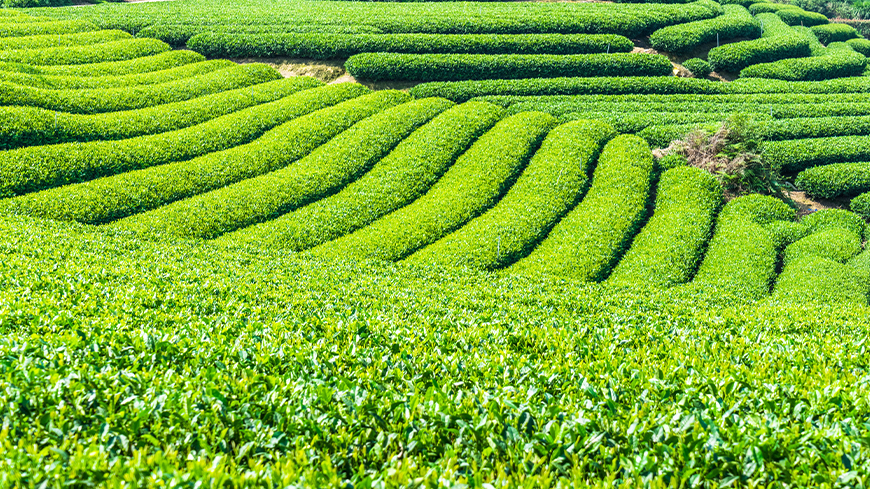
Tea Fields in North Vietnam - Photo : FreePik
TEA, THE OTHER ESSENTIAL DRINK IN THE VIETNAMESE CULTURE
Tea is an essential drink in Vietnam, consumed at any age and on any occasion, and it plays a significant role in Vietnamese society.
Origins and symbolism of tea in Vietnam
Tea in Vietnam has a history that goes back several millennia. The first signs of tea cultivation in the country date back to the 3rd century BC, during the Han dynasty. Tea has become a popular drink over the centuries and appreciated for its health benefits. It is also related to a number of symbols, including wisdom, peace and purity. Many Vietnamese traditions and customs are linked to this long history.
Did you know? Vietnam also has its traditional tea ceremony, called trà dao. This ritual is often performed during religious or cultural ceremonies and is presented as a sophisticated art that requires great mastery.
Socio-cultural role of tea in Vietnam
Tea is important for Vietnamese society. It represents hospitality and friendship and is often used to mark special occasions like weddings, birthdays or parties. It shows respect and a sense of welcome when offered to guests as a sign of welcome.
And finally, tea is also used in traditional Vietnamese medicine, where it is considered a healthy drink, and is often used to treat certain diseases – especially cardiovascular, digestive and infectious diseases.
The different kinds of tea in Vietnam
Vietnam is a renowned tea-producing country, producing a wide variety of beverages, the most popular of which are:
- ♦ Green tea: it is the most consumed type of tea in Vietnam. It is known for its health benefits, including its ability to prevent cardiovascular disease and cancer. It is often made from fresh tea leaves, which are steamed to preserve antioxidants.
- ♦ Black tea: less popular than green tea, but equally appreciated for its rich, full-bodied taste. It is produced from dried tea leaves, which are then fermented to develop their flavor.
- ♦ Oolong tea: it is a semi-fermented tea, which offers a perfect balance between the flavors of green tea and black tea. Here, the dried leaves are partially fermented to obtain this typical flavor
Flavored tea: it is often scented with flowers, such as jasmine or lotus. Green or black tea leaves are used, which are scented with natural flowers or essential oils.
Between lifestyle, culture and philosophy, tea in Vietnam is much more than a drink. By discovering Vietnamese tea, you will immerse yourself in a tradition rich in history, culture and philosophy, while enjoying its health benefits. A sensory and spiritual experience that deserves to be explored during your trip.
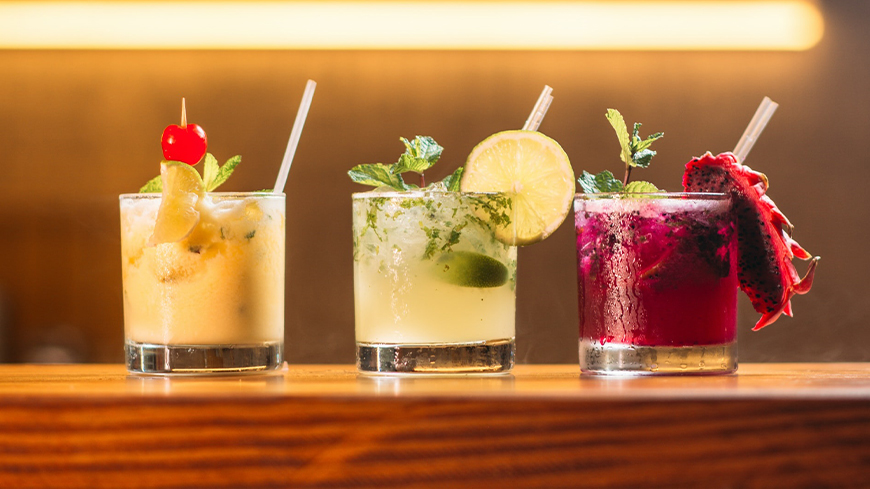
Delicious Vietnamese Fruit Juices - Photo : Internet
FRUIT JUICE, THE TROPICAL FLAVORS
In Vietnam, fruit juices are a popular drink, especially during the warmer months. Fresh fruits are abundant in Vietnam, thanks to the country’s tropical climate. They are usually served mixed with crushed ice.
Vietnam has a tradition of serving fresh fruit juices at weddings and other parties, as they are considered a festive and joyful drink. As part of the Vietnamese culture, fruit juices will also be found as offerings to the ancetres (who, we think, are fond of them…).
You will not fail to taste:
- ♦ Orange juice: Orange juice is a popular juice in Vietnam because it is fresh and nutritious. It is often served with sugar or honey.
- ♦ Pineapple juice: Pineapple juice is another popular juice in Vietnam. It is sweet and refreshing. It is often served with ice.
- ♦ Mango juice: Mango juice is a delicious and sweet juice. It is often served with ice cream and condensed milk.
- ♦ Watermelon Juice: Watermelon juice is a refreshing drink. It is often served with ice.
- ♦ Guava juice: Guava juice is a healthy and nutritious juice. It is often served with ice
Passion fruit juice and coconut water complete this no exhaustive list. Indeed, in addition to these classic fruit juices, Vietnam also offers a variety of exotic fruit juices, such as dragon fruit juice, mangosteen juice and rambutan juice. Not only delicious but also nutritious and good for health, these drinks are often served in street stalls.

Bia Hoi in Ha Noi - Photo : Internet
BEER, A POPULAR AND CULTURAL DRINK
Beer, or bia in Vietnamese, is one of the most consumed alcoholic beverages in Vietnam. The figures speak of 43 liters/ person/ year during 2019! Beer often accompanies meals, parties, birthdays, weddings or Tet (the lunar new year in Vietnam).
Origins of the beer in Vietnam
Towards the end of the 19th century, the French did not only import coffee, laughing cow and broccoli, they also installed breweries in Vietnam - Saigon having seen the birth of the very first, in 1875. Over the years, beer production in the Palanche Country has increased significantly, making Vietnam today one of the largest beer producers in Southeast Asia.
The socio-cultural role of beer in Vietnam
Beer plays an important role in Vietnamese culture. It is often served to spend time with friends and family or for special occasions such as weddings, birthdays and parties. In fact, this irresistible golden drink plays an important socio-cultural role in promoting friendliness, friendship and solidarity between people. It also represents a dynamic, modern and globalized culture.
Did you know that? It is necessary to count up to three to toast in Vietnamese: "Một, hai, ba... Yo!"
What kind of beer do we drink in Vietnam?
In Vietnam, there are a variety of beers available, ranging from local beers to international beers. Some of the most popular brands that reflect the country’s cultural and geographic diversity include:
- ♦ Saigon Beer : Since 1875, Saigon beer, also known as Bia Saigon, has been produced in Ho Chi Minh City. It comes in several versions, including Saigon Special, Saigon 333, Saigon Export and Saigon Lager, and has a unique Asian rice flavor.
- ♦ Hanoi Beer : Since 1890, Hanoi beer, also known as Bia Hanoi, has been brewed in the capital. It is golden in color and belongs to the low fermentation pils type.
- ♦ Beer of Hue : The imperial city of Hue is the origin of Bia Hue. It is produced during the Hue festival under the name of Huda and has an alcohol content of 5%.
- ♦ Larue : Made in Da Nang since 1909, it is one of the cheapest and most appreciated in terms of taste.
- ♦ Tiger Beer : It is a brand originally from Singapore but is also produced in Vietnam. It has an alcohol content of 5% and is widespread in Asia.
- ♦ Heineken Beer : This world-renowned Dutch brand asserts its position not only in Vietnam but also in the world. With its 5% alcohol content, it offers consumers a new experience full of fun and creativity.
In addition to these industrial beers, there is also a craft beer called bia hơi, which is brewed daily and sold in popular establishments called bia hơi. Bia hơi is a light beer served fresh directly from the barrel, with an alcohol content of about 3%. In general, it is brewed with rice and malt, and has a light and slightly sweet taste. It is allowed to drink it with ice cube...
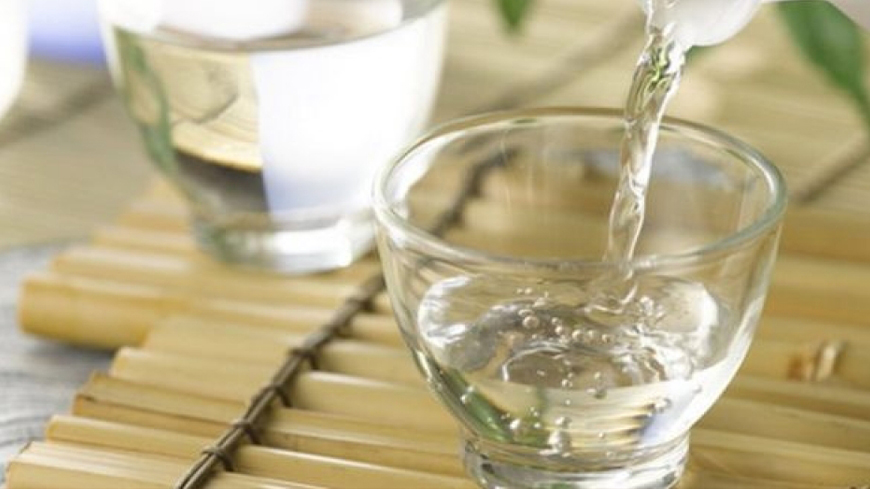
Rice Wine, a cultural drink in Vietnam - Photo : Bao Quoc Te
RICE WINE, AN ANCESTRAL DRINK IN VIETNAM
Rice wine, also known as rice alcohol, is a traditional Vietnamese drink that is produced through the fermentation and distillation of rice, often glutinous rice, or sometimes corn in some mountainous regions. Its manufacturing process is quite long and complex, and there are many regional variations.
Origins and history of rice wine in Vietnam
It is believed that rice wine production in Vietnam dates back several thousand years. The first traces of rice wine were found in archaeological sites dating from the Neolithic period. He admitted that of that time, this drink was an important drink in Vietnamese culture, often used during religious ceremonies and festivals.
Nowadays, rice wine is still a popular drink in Vietnam, still very often served on special occasions, such as weddings, birthdays and lunar new year celebrations. It is also used in Vietnamese cuisine, where it is often added to soups, meat dishes and desserts.
Its role in Vietnamese society
Rice wine plays an important role in Vietnamese society. Considered a social drink, it is often used to celebrate special occasions or simply to spend time with friends and family.
It is often offered as a gift or as a sign of respect to guests, friends or seniors, because it represents friendliness, brotherhood and good humor. It is also used as an offering to worship deities or ancestors. It is also famous for its medicinal or aphrodisiac properties, depending on the added ingredients, such as animals, spices, herbs or fruits. Ruou ran, also known as snake alcohol, is the best known and most surprising rice wine in this category, which contains one or more venomous snakes macerated in a liquid. It is supposed to give to the one who drinks it strength, vigor and longevity.
Varieties of rice wine in Vietnam
Depending on the ingredients, the manufacturing methods and the regions of origin, rice wine will be different. Ruou trang, also known as white alcohol, is the most common rice wine. It has a light colour and a strong taste, around 30 degrees. It is consumed as wine, during meals or as a digestive. Ruou can, also known as straw alcohol, is another type of alcohol, less strong and sweeter, which is drunk in terracotta jars with long bamboo straws. Ethnic minorities in the North mainly consume this drink at parties or ceremonies.
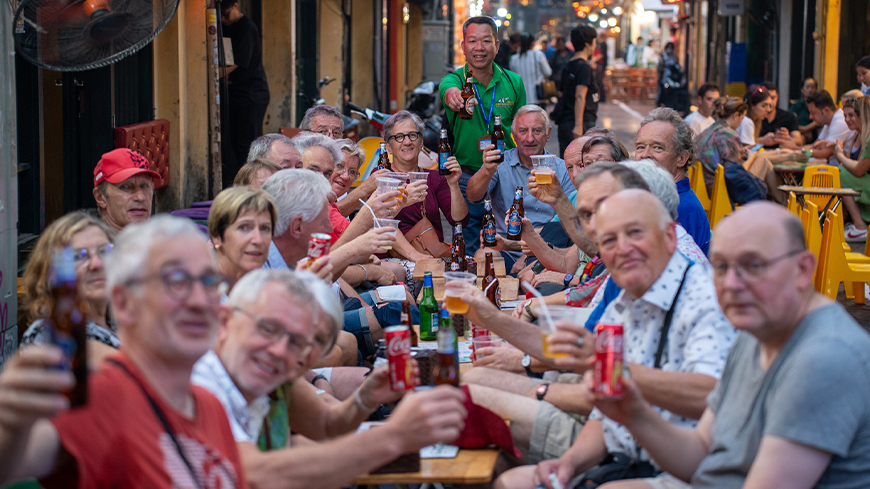
Ta Hien street, Ha Noi - Photo : Mr Linh's Adventures
How to drink it
Although rice wine is a delicious drink and essential to Vietnamese culture, we must respect some rules of moderation and decency.
It is important to toast before drinking by saying "yo" or "dzo" and raising your glass to the height of others. Rice wine is a shared and tasty drink... dry ass, without wincing and expressing our gratitude to the one who served us. You should not drink alone or refuse a free drink unless you have a good reason. It is important to know how to stop in time because rice wine can quickly go to the head and cause negative effects.
ONE FOR THE ROAD BEFORE TO CONCLUDE!
To conclude, drinks in Vietnam are a real taste and sensory journey. They reflect the richness and creativity of the Vietnamese people, who have made the most of their environment and cultural influences. Whether you are a fan of coffee, tea, fruit juice, beer or rice alcohol, you will surely find your happiness in the streets, markets or cafes of Vietnam. Do not hesitate to taste the different regional specialties and be surprised by the exotic and original flavors of this fascinating country.